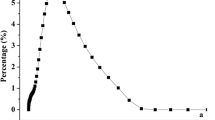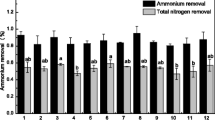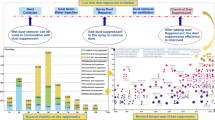Abstract
At present, microbial dust suppressants based on microbial communities lack necessary systematic analysis of factors affecting dust suppression performance. Therefore, in this study, the response surface curve method was used to optimize the culture conditions for enrichment of urease-producing microorganisms from activated sludge. The results indicated that when urea = 9.67 g L−1, NH4Cl = 5.21 g L−1, and pH = 9.57, the maximum urease activity of urease-producing microbial community (UPMC) was 8.22 mM min−1. The UPMC under optimized culture conditions reached a mineralization rate of 98.8% on the 1st day of mineralization. Ureolysis is one of the biological mechanisms that trigger microbial mineralization with the consequent effect of dust suppression. The analysis of microbial community structure indicated that the urease-producing bacteria Sporosarcina sp. had the highest abundance at the genus level in the microbial-based dust suppressant compound. Jeotgalicoccus sp. plays an important role in improving and maintaining the stability of urease. In addition, the optimal UPMC had low pathogenicity, which is extremely attractive for the safe application of microbial dust suppressants.





Similar content being viewed by others
Data availability
All data generated or analyzed during this study are included in this paper.
References
Ahmad J, Khan MA, Ahmad S (2023) State of the art on factors affecting the performance of MICP treated fine aggregates. Mater Today: Proc In Press
Allouss D, Essamlali Y, Amadine O, Chakir A, Zahouily M (2019) Response surface methodology for optimization of methylene blue adsorption onto carboxymethyl cellulose-based hydrogel beads: adsorption kinetics, isotherm, thermodynamics and reusability studies. RSC Adv 9:37858–37869
Anbu P, Kang CH, Shin YJ, So JS (2016) Formations of calcium carbonate minerals by bacteria and its multiple applications. Springerplus 5:250
Cai P, Nie W, Hua Y, Wei W, Jin H (2018) Diffusion and pollution of multi-source dusts in a fully mechanized coal face. Process Saf Environ Prot 118:93–105
Chen L, Song Y, Fang H, Feng Q, Lai C, Song X (2022) Systematic optimization of a novel, cost-effective fermentation medium of Sporosarcina pasteurii for microbially induced calcite precipitation (MICP). Constr Build Mater 348:128632
Cheng L, Cord-Ruwisch R (2013) Selective enrichment and production of highly urease active bacteria by non-sterile (open) chemostat culture. J Ind Microbiol Biotechnol 40:1095–1104
Cheng L, Shahin MA, Chu J (2018) Soil bio-cementation using a new one-phase low-pH injection method. Acta Geotech 14:615–626
Cheng WM, Liu JD, Feng Y, Hu XM, Zhao YY, Liu Y (2024) Study on the cooperation mechanism of urea-hydrolysis bacteria and biosurfactant bacteria for dust suppression. Chem Eng J 480:148008
Cotta MA, Whitehead TR, Collins MD, Lawson PA (2004) Atopostipes suicloacale gen. nov., sp. nov., isolated from an underground swine manure storage pit. Anaerobe 10:191–195
Esfe MH, Alidust S, Motallebi M, Toghraie D (2023) Investigation of different transfer functions for modeling the dynamic viscosity of hybrid nanolubricant containing MWCNTs and MgO nanoparticles using the response surface methodology (RSM). Tribol Int 183:108370
Fan Y, Hu X, Zhao Y, Wu M, Wang S, Wang P, Xue Y, Zhu S (2020) Urease producing microorganisms for coal dust suppression isolated from coal: Characterization and comparative study. Adv Powder Technol 31:4095–4106
Fan Y, Zhao Y, Hu X, Cheng W, Tang X, Zhu S, Song C (2021) Material optimization of microbial dust suppressant nutrient solution based on response surface curve. Powder Technol 385:29–36
Farashahi M, Bagherpour R, Kalhori H, Ghasemi E (2019) Application of bacteria for coal dust stabilization. Environ Earth Sci 78:1–9
Fu T, Saracho AC, Haigh SK (2023) Microbially induced carbonate precipitation (MICP) for soil strengthening: a comprehensive review. Biogeotechnics 1:100002
Gebru KA, Kidanemariam TG, Gebretinsae HK (2021) Bio-cement production using microbially induced calcite precipitation (MICP) method: a review. Chem Eng Sci 238:116610
Gorospe CM, Han S, Kim S, Park J, Kang C, Jeong J, So J (2013) Effects of different calcium salts on calcium carbonate crystal formation by Sporosarcina pasteurii KCTC 3558. Biotechnol Bioprocess Eng 18:903–908
Hamzah A, Phan C, Abu Bakar NF, Wong K (2013) Biodegradation of crude oil by constructed bacterial consortia and the constituent single bacteria isolated from Malaysia. Bioremediat J 17:1–10
Han F, Liu J (2018) Flow field characteristics and coal dust removal performance of an arc fan nozzle used for water spray. PLoS One 13:e0203875
Hostacká A, Ciznár I, Stefkovicová M (2010) Temperature and pH affect the production of bacterial biofilm. Folia Microbiol 55:75–78
Konstantinou C, Wang Y, Biscontin G, Soga K (2021) The role of bacterial urease activity on the uniformity of carbonate precipitation profiles of bio-treated coarse sand specimens. Sci Rep 11:6161
Lapierre FM, Huber R (2024) Revisiting the urease production of MICP-relevant bacterium Sporosarcina pasteurii during cultivation. Biocatal Agric Biotechnol 55:102981
Li D, Tian K, Zhang H, Wu Y, Nie K, Zhang S (2018) Experimental investigation of solidifying desert aeolian sand using microbially induced calcite precipitation. Constr Build Mater 172:251–262
Li M, Wang H, Wang D, Shao Z, He S (2020) Risk assessment of gas explosion in coal mines based on fuzzy AHP and bayesian network. Process Saf Environ Prot 135:207–218
Liu WY, Jiang LL, Guo CJ, Yang SS (2011) Jeotgalicoccus halophilus sp. nov., isolated from salt lakes. Int J Syst Evol Microbiol 61:1720–1724
Liu D, Shao AL, Li H, Jin CY, Li YL (2020) A study on the enhancement of the mechanical properties of weak structural planes based on microbiologically induced calcium carbonate precipitation. Bull Eng Geol Env 79:4349–4362
Liu W, Zhao Y, Hu X, Li X, Geng Z, Wang Q, Liu J, Wang H, You G (2022) High performance of coal dust suppression with waste activated sludge using microbially induced calcite precipitation technology. Powder Technol 404:117464
Ma L, Pang AP, Luo Y, Lu X, Lin F (2020) Beneficial factors for biomineralization by ureolytic bacterium Sporosarcina pasteurii. Microb Cell Fact 19:12
Madejón E, Burgos P, López R, Cabrera F (2001) Soil enzymatic response to addition of heavy metals with organic residues. Biol Fertil Soils 34:144–150
Naeimi M, Chu J, Khosroshahi M, Kashi Zenouzi L (2023) Soil stabilization for dunes fixation using microbially induced calcium carbonate precipitation. Geoderma 429:116183
Namdar-Khojasteh D, Bazgir M, Hashemi Babaheidari SA, Asumadu-Sakyi AB (2022) Application of biocementation technique using Bacillus sphaericus for stabilization of soil surface and dust storm control. J Arid Land 14:537–549
Omoregie AI, Khoshdelnezamiha G, Senian N, Ong DEL, Nissom PM (2017) Experimental optimisation of various cultural conditions on urease activity for isolated Sporosarcina pasteurii strains and evaluation of their biocement potentials. Ecol Eng 109:65–75
Sang G, Lunn RJ, El Mountassir G, Minto JM (2023) Meter-scale MICP improvement of medium graded very gravelly sands: lab measurement, transport modelling, mechanical and microstructural analysis. Eng Geol 324:107275
Song C, Zhao Y, Cheng W, Hu X, Zhu S, Wu M, Fan Y, Liu W, Zhang M (2021) Preparation of microbial dust suppressant and its application in coal dust suppression. Adv Powder Technol 32:4509–4521
Sun T, Miao J, Saleem M, Zhang H, Yang Y, Zhang Q (2020) Bacterial compatibility and immobilization with biochar improved tebuconazole degradation, soil microbiome composition and functioning. J Hazard Mater 398:122941
Tao M, Lu DM, Shi Y, Liu K, Yan DD, Memon MB (2024) Life cycle assessment of coal mines of diverse scales over time in China. Sci Total Environ 912:169236
Trechera P, Moreno T, Córdoba P, Moreno N, Zhuang X, Li B, Li J, Shangguan Y, Dominguez AO, Kelly F, Querol X (2021) Comprehensive evaluation of potential coal mine dust emissions in an open-pit coal mine in Northwest China. Int J Coal Geol 235:103677
Wang P, Han H, Tian C, Liu R, Jiang Y (2020) Experimental study on dust reduction via spraying using surfactant solution. Atmos Pollut Res 11:32–42
Wang Y, Sun X, Miao L, Wang H, Wu L, Shi W, Kawasaki S (2024) State-of-the-art review of soil erosion control by MICP and EICP techniques: problems, applications, and prospects. Sci Total Environ 912:169016
Whiffin VS (2004) Microbial CaCO3 precipitation: for the production of biocement. Murdoch University Doctoral dissertation
Wu M, Hu X, Zhang Q, Zhao Y, Sun J, Cheng W, Fan Y, Zhu S, Lu W, Song C (2020) Preparation and performance evaluation of environment-friendly biological dust suppressant. J Clean Prod 273:123162
Yang Y, Chu J, Xiao Y, Liu H, Cheng L (2019) Seepage control in sand using bioslurry. Constr Build Mater 212:342–349
Yang Y, Chu J, Cao B, Liu H, Cheng L (2020) Biocementation of soil using non-sterile enriched urease-producing bacteria from activated sludge. J Clean Prod 262:121315
Yu XN, Pan XH (2023) Seawater based bio-cementation for calcareous sand improvement in marine environment. Mar Georesour Geotechnol 41:949–958
Zhang L, Zhou G, Ma Y, Jing B, Sun B, Han F, He M, Chen X (2021) Numerical analysis on spatial distribution for concentration and particle size of particulate pollutants in dust environment at fully mechanized coal mining face. Powder Technol 383:143–158
Zhang YS, Liu Y, Sun XD, Zeng W, Xing HP, Lin JZ, Kang SB, Yu L (2024) Application of microbially induced calcium carbonate precipitation (MICP) technique in concrete crack repair: a review. Constr Build Mater 411:134313
Zheng Y, Wang A (2010) Removal of heavy metals using polyvinyl alcohol semi-IPN poly(acrylic acid)/tourmaline composite optimized with response surface methodology. Chem Eng J 162:186–193
Zhu S, Zhao Y, Hu X, Wu M, Cheng W, Fan Y, Song C, Tang X (2021) Study on preparation and properties of mineral surfactant-microbial dust suppressant. Powder Technol 383:233–243
Zomorodian SMA, Ghaffari H, O’Kelly BC (2019) Stabilisation of crustal sand layer using biocementation technique for wind erosion control. Aeol Res 40:34–41
Funding
This work was supported by the National Natural Science Foundation of China (42077444, 52274217, and 52274216); Youth expert of Taishan Scholars (No. tsqn202103073), Distinguished professor of Taishan Scholars (TS20190935); Shandong Natural Science Outstanding Youth Fund (ZR2021JQ19); Shandong Province Natural Science Foundation (ZR2020ME101, ZR2021QE159, and ZR2021QE296); 2022 Innovation and Entrepreneurship Training Program for College Students of Shandong University of Science and Technology (X202210424008).
Author information
Authors and Affiliations
Contributions
Xiangming Hu: formal analysis, funding acquisition, project administration. Zhiyuan Yang: conceptualization, supervision, validation. Yanyun Zhao: conceptualization, methodology, supervision, funding acquisition, writing—review and editing. Yue Dong: conceptualization, methodology, writing—original draft, investigation. Chengcheng Wang: conceptualization, methodology. Linlin Zhang: investigation, conceptualization. Yiyun Yu: investigation, conceptualization. Kai Wu: writing review and editing. Liyan Ren: writing review.
Corresponding author
Ethics declarations
Ethics approval
Not applicable.
Consent to participate
Not applicable.
Consent for publication
Not applicable.
Competing interests
The authors declare no competing interests.
Additional information
Responsible Editor: Diane Purchase
Publisher's Note
Springer Nature remains neutral with regard to jurisdictional claims in published maps and institutional affiliations.
Supplementary Information
Below is the link to the electronic supplementary material.
Rights and permissions
Springer Nature or its licensor (e.g. a society or other partner) holds exclusive rights to this article under a publishing agreement with the author(s) or other rightsholder(s); author self-archiving of the accepted manuscript version of this article is solely governed by the terms of such publishing agreement and applicable law.
About this article
Cite this article
Hu, X., Yang, Z., Zhao, Y. et al. Medium optimization and dust suppression performance analysis of microbial-based dust suppressant compound by response surface curve method. Environ Sci Pollut Res 31, 24525–24535 (2024). https://doi.org/10.1007/s11356-024-32748-6
Received:
Accepted:
Published:
Issue Date:
DOI: https://doi.org/10.1007/s11356-024-32748-6




